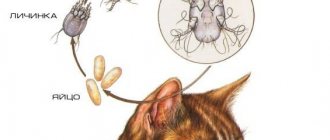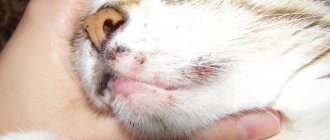Features of the structure and development of the parasite
Ear mites in cats are an arthropod parasite whose length reaches 0.5 mm. Its body looks elongated, has an oval shape, and a yellow tint. The tick goes through a development cycle of 20 days, then lays new eggs and dies. Itching and discomfort in the animal occur during the period of activation of the eggs.
Ear mite
Important! A cat's ears are a favorable environment for the parasite to survive. They accumulate a sufficient amount of moisture and heat. Earwax does not prevent the pathogen from colonizing; it survives and feeds on it.
The pathogen spreads through the tissues of the ears, laying eggs in them. At this moment, acute itching begins, due to which the cat scratches its ears, until blood appears. An adult tick damages the skin and mucous membranes and sucks blood. In the process of life, it releases waste and toxins. Their accumulation leads to activation of the immune system, which results in an acute inflammatory process. Excessive amounts of sulfur and swelling appear, which reduces hearing.
The parasite develops from eggs. This usually happens in the spring. Young individuals appear, which increase in size as they grow older and consume blood and lymph. When they reach the adult stage, they begin laying eggs again. The mite does this in the outer layers of the epidermis.
Complications
If the disease is ignored, it gradually leads to a deterioration in the animal’s health. Some conditions can be very dangerous and even fatal. Among the unpleasant consequences:
- spread of the lesion to other parts of the body;
- self-injury (due to scratching);
- purulent otitis;
- hematoma of the auricle;
- inflammation of the lymph nodes under the jaw;
- damage to the central nervous system;
- meningitis;
- deafness.
How can an animal become infected with ear mites?
The source of the disease is infectious animals. Close contact is required for the parasites to penetrate the cat's fur. Along it they spread to the outer ear area, where the reproduction cycle begins. Without a host organism, the tick quickly dies in environmental conditions. He needs no more than 2 months for this.
Scabies in cats: mite, treatment at home
Examination of a cat with ear mites
Both an adult and a kitten can become infected. In addition to close contact, ear mites in cats can be transmitted through contact with the following objects:
- combs;
- animal houses;
- toys;
- not sterile instruments from veterinarians;
- carrying;
- a person who has carried the parasite on clothes, hands, shoes;
- an insect that carries microscopic eggs or young.
The reproduction and life cycle of ticks begins in the spring. It is during this period of time that it is dangerous to take a cat outside, as it comes into contact with other individuals. Ticks can even spread through grass after an infected animal passes through it.
Attention! Ear scabies are more common in young individuals.
Cats do not always become infected. This is preceded by a decrease in the function of the immune system and the presence of a recent illness.
Prevention
If you take preventive measures in advance, then otodectosis in cats can be prevented or at least reduced the risk of infection. Experts give the following recommendations:
- periodically inspect the ears and clean them;
- strengthen immunity;
- regularly clean the house (dry and wet);
- try to avoid contact with sick animals.
If your pet walks outside, then it is necessary to treat the fur with special acaricidal agents.
Otodectosis can be easily and quickly dealt with if the disease is detected at the initial stage. Therefore, you should carefully monitor your cat’s condition and periodically examine her ears so as not to miss the first symptoms.
Symptoms of infection
Scabies in the ears of cats is accompanied by characteristic clinical symptoms. Most often found:
- anxiety of the animal, it begins to twitch, rub its ears, behave aggressively, rub against people’s legs, household objects;
- within 1-2 weeks, a brown or yellow discharge appears from the ears;
- a putrid smell appears;
- if there is no treatment within 2 weeks, the pet becomes lethargic, tired, sleeps a lot in between itching;
- at week 3, hearing begins to gradually decrease, after 1 month it may be completely absent;
- a sharp increase in the amount of sulfur, which forms traffic jams;
- Bloody wounds covered with yellow crusts appear in the ears from constant scratching.
Ear mites in cats: drops, treatment, effective drugs
Important! Sometimes pus, crusts and wax plugs so close the ear canal that a person cannot eliminate the pathological process on his own. Therefore, ear mites in cats cannot be cured without the intervention of a veterinarian.
Medications
In case of severe infection, detection of blood clots, pus in the animal’s ears, it is possible to get rid of parasites only with the help of broad-spectrum drugs. Before purchasing, make sure that the list of indications for the drops or spray includes Otodectes cynotis.
In veterinary pharmacies, drugs used to treat otodectosis in cats and combat parasites are presented in an assortment. It can be:
- aerosols with insectoacaricidal action (Acrodex, Tsiodrin, Dermatosol), which should be sprayed onto the affected areas, holding the bottle a few centimeters from the ear;
- ointments, the composition of which is based on nicochloran, phenothiazine and other insectoacaricides;
- drops (Otoferonol, Amitrazine, Bars, Amitraz, etc.);
- powders (boric acid).
After applying the drugs, you need to do a light massage so that the medicinal composition is evenly distributed. Compliance with the dosage is considered a mandatory rule for the use of medications, because the compositions contain poisons that are dangerous for your four-legged friend. If other types of pets are infested, they may need other medications.
Diagnostics
Rhinotracheitis in cats: symptoms and treatment at home
You can recognize the presence of ear mites in a cat yourself. To do this, take a sterile cotton swab, but a cotton swab is better. Wear gloves so as not to subsequently transfer the pathogen with your own hands. A cotton swab is inserted deep into the animal's ear. You should take a smear containing earwax, pus, and microorganisms.
Examination by a veterinarian
The contents of the cotton swab are shaken onto paper. A bright light is directed at it, examined through a magnifying glass. The parasite should be separated from the earwax. If yellow dots appear on the paper and move around, this is a clear sign of mites.
The veterinarian does the same diagnostic process. But unlike at home, he will be able to examine the pathogen under a microscope, accurately determining its classification.
Ticks under a microscope
If pus appears in the ears, this is a sign of a microflora disorder. Due to the presence of mites, pathogenic microflora multiplies in the cat's ears. Therefore, they take a smear and send it for bacteriological culture. Identify the exact bacteria and the antibiotic to which they are sensitive.
Ear mites: treatment at home
Even in cases of prolonged ear mite infestation, treatment usually takes no more than a month. Therapy can be longer and more complex if the animal already has a violent inflammatory process, the formation of pus or damage to the eardrums.
For treatment at home, it is important to follow a number of rules:
- Personal hygiene measures - a sick animal should be isolated. When processing ears, cleaning and other manipulations, you must use gloves. After any manipulation, you must wash your hands and face with soap.
- Treatment of ear mites is always accompanied by the use of veterinary or medicinal drugs. Never ignore reading the instructions or increase the dosage or frequency of treatment without doctor's orders.
- Regardless of the treatment tactics you choose, recovery will come faster if you regularly clean your cat's ears.
Note! Recovery will be faster if the cat does not scratch its ears, so it is wise to use an Elizabethan collar. If your cat suffers from itching, antihistamines should be used to reduce its discomfort.
Cleaning ears with hydrogen peroxide, chlorhexidine and veterinary products
You need to understand that ear mite treatment will not be effective if basic hygiene rules are ignored. Be mentally prepared for the fact that you will have to clean your pet’s ears every day, or even several times a day.
Important! If the ears remain dirty, the use of drops, sprays, ointments and other means to treat ear mites will not be effective.
Cleaning the ears is carried out according to the following algorithm:
- Soaking the crusts.
- Gently remove soft dirt.
- Thorough cleaning of folds.
If you skip the first stage, you will tear off the scabs alive, and this is accompanied by severe pain. In addition, the appearance of open wounds in infected ears will only worsen the pet’s condition. To soak the crusts and superficially clean the skin of the ears, hydrogen peroxide, chlorhexidine or special veterinary lotions are used.
- Hydrogen peroxide does not pose a danger to the animal, even if there are open wounds in the ears.
- Chlorhexidine soaks the crusts, disinfects and slightly soothes the skin.
- Veterinary lotions vary greatly in composition, but they all have an antibacterial and softening effect.
Folk remedies for cleaning ears
If you do not want to use veterinary or pharmacy products to clean the ear, you can resort to traditional methods. Note that lotions, hydrogen peroxide and chlorhexidine soak the crusts faster, but in the presence of extensive wounds they may cause some discomfort.
The following can be used as folk antiseptic lotions:
- Green loose tea.
- Black loose leaf tea is a very strong infusion.
- Vegetable oils.
Important! To clean your ears, the tea leaves or oil need to be heated to a comfortable temperature. In addition, it is strictly not recommended to use the same tea leaves for several days.
Ear mites in cats: stages of the disease
During the development process from egg to adult, the parasite develops several stages of damage.
- Microcracks or major trauma to the skin and mucous membranes form in the ears. The parasite penetrates this area, damaging the epidermis. Through the hole it has access to blood and lymph, which it feeds on. During their life, mites secrete toxic products, which cause severe itching and other immunological reactions.
- Damage to the walls of blood vessels with the formation of swelling and redness of the affected area.
- Purulent discharge may form on the skin due to the development of an immune reaction.
- Exudate together with waste products of the mite form brown scabs. Pathogenic microflora begins to multiply, resulting in increased inflammation and suppuration.
- A crust accumulates in the animal's ears. It blocks the passage, which causes decreased or absent hearing.
Attention! If the infection is not treated in a timely manner, the pathological process spreads all the way to the eardrum and inner ear.
Medicines against ear mites in cats
To completely remove mites from cats' ears, it is recommended to use a medication. If they are not used, the pathogen may remain inside the ear canals. Since the parasite goes through several stages of development, a single use of medication may not help. Therefore, they are used repeatedly to destroy new individuals that have developed from eggs.
Ear drops
Treatment is carried out in several stages.
- Cleaning the external auditory canals from crusts, pus, scabs, and earwax. A veterinarian can help with this. In his office, he completely cleans the ear canal using special tools.
- Cleaning with antiseptics. A solution of furatsilin, chlorhexidine, and hydrogen peroxide will help get rid of bacteria and toxins. They not only destroy pathogenic microflora, but also wash out a certain proportion of parasites. The product is applied to a cotton swab. Directly pouring the solution into the ear is prohibited.
- Use of anti-tick medications. They are used in the form of ointments, drops, and gels. It is recommended to use drops during the daytime. They are applied strictly according to the instructions, up to three times a day. It is recommended to apply ointment or gel at night so that the drug has a long-lasting effect. They use Amitrazine, Tactic, Otoferonol.
- When the pathogen spreads strongly in the eardrum or inner ear, injectable drugs are used. One of them is Ivermectin. It is used only in extreme cases, since the active substance penetrates the liver and causes the destruction of some hepatocytes. Therefore, during therapy, biochemical blood tests are periodically taken to determine liver enzymes. You should follow the step-by-step instructions to avoid adverse reactions.
- Antimicrobial drugs with anti-inflammatory effects. One of them is Otonazole. The ointment not only has a bactericidal effect, but also treats fungal infections. It is used for active reproduction of pathogenic microflora.
- To relieve itching and eliminate the possibility of mites actively reproducing, oils and creams are used. They soften the skin and crusts formed on wounds. After their application, it is easier to remove foreign objects from the ear canal.
- Immunotherapy. They use Gamavit, Gamapren. They stimulate the synthesis of the cat’s own immune cells, thereby enhancing the destruction of pathogenic microorganisms. The animal is able to fight the infection on its own.
In addition to medications, diet is used during treatment. The pet's diet at this time should be varied. It should include all the beneficial substances, microelements, vitamins, and minerals necessary to strengthen the immune system.
Important! Cat ear mites can spread indoors. Therefore, from the moment parasites are identified, all household items are thoroughly disinfected. This eliminates the risk of re-infection.
List of drugs
The following dosage forms are used:
- Ointment (gel, liniment):
- Ivermek-gel.
- Amidel-gel.
- Aversectin ointment.
- Drops:
- Surolan
- Aurikan.
- Amitrazine.
- Ectodex.
- Anandin plus.
- Amit.
- Dekta
- Dana.
- Mycodemocid.
- Acaricidal emulsions, aerosols:
- Ivermec spray.
- Unoiled.
Ivermek-gel
The active ingredients are the acaricide Ivermectin, an analgesic and a wound healing agent. Both hearing organs are treated, even if only one is affected, 1…2 times, duplicating them after 5…7 days. Contraindicated for breeds sensitive to Ivermectin, convalescent and malnourished cats.
Amidel-gel
Active components - acaricide, analgesic, antimicrobial agent, auxiliary wound healing substances. Both channels are processed 1…2 times, duplicating, after 5…7 days. Contraindicated in kittens up to 2 weeks old, convalescent, and sick.
Aversectin ointment
The active component is Aversectin. To clean the ear from crusts, additional means are needed - lotions or Perhydrol. The wool is cut. Apply the ointment, fold the shell in half, and massage the base of the ear. Contraindicated for breeds sensitive to Aversectin, kittens under 2 months old, lactation, convalescent, and sick.
Surolan
Ear drops. Intended for advanced cases, with the addition of secondary microflora. Contains antimycotic and antimicrobial components, a steroidal antiphlogistic agent. Buried daily for 14 days. Contraindicated in case of perforation of the tympanic membrane.
Aurikan
Ear drops. Contains Diazinon (organophosphorus acaricide), antiseptic, analgesic, synthetic glucocorticoid antiphlogistic agent. The first week the drug is instilled daily, the next three - every 3 days.
Amitrazine
Ear drops. The active ingredients are acaricide Amitraz and Dimexide, which have antiseptic, anti-inflammatory and analgesic properties. The ear is folded and massaged. Treatments are repeated every other week until symptoms disappear.
Ectodex
Ear drops based on Propolis and Sulfur. Preliminary cleaning of the ear canal from secretions is required. Treatment consists of two or three treatments every 5...7 days. The medicine is contraindicated for pregnant, lactating, and animals under one month of age. Do not use the drug if the integrity of the drum membrane is damaged.
Anandin plus
Anandin plus
Ear drops. The main active ingredients are the acaricide Permethrin, the immunostimulant Anadin, and the antiseptic Gramicidin. Preliminary cleaning of the ears is carried out with the same drug used for treatment. The hearing organs are massaged after instillation of the medicine. Therapy lasts 3...7 days. If the use of Anandin is missed once, the course of treatment is resumed.
If the cat shakes its head, prevent droplets from splashing with restraint. Contraindication: violation of the integrity of the tympanic membrane.
Amit
Ear drops consisting of Amitraz and Prednisolone. The crusts are soaked with a swab soaked in Amit. Ears are treated twice a day. The course of treatment is 3...5 days. If a second infection occurs, change the drug. Contraindications: gestation, lactation, age less than 2 months.
Dekta
Dekta
Ear drops consisting of Amitraz, Propolis and Dexamethasone. Apply once, with an interval of 5...7 days. Number of treatments 2…3. Contraindications: gestation, lactation, age less than a month.
Dan's drops
Dan's drops
Dana
Drops in the form of pipettes. The main component is the organophosphate disinfestant Diazinon.
After instilling the medicine, the ears are massaged. A week later, the treatment is duplicated. The medicine should not be used by pregnant or lactating animals, as well as animals under 10 weeks of age.
Mycodemocid
Drops. Consist of Sea buckthorn oil, Chlorophos, detergent Isopropyl alcohol. Treat once and repeat 7 days later if necessary. Contraindicated in pregnant and lactating animals, young animals under 10 weeks of age.
Ivermek-spray
Analogue of Ivermek-gel. Inject into the ears twice with an interval of 3...5 days. Put on the Elizabethan collar until the surface of the ear dries to avoid licking. The drug is not prescribed to animals under three months of age, lactating animals, matrons, and cats that are hypersensitive to Ivermectin.
Acaromectin
Active ingredient: Ivermectin. Moisten the affected area generously. The treatment is repeated after 8…10 days. Requires 3...4 injections. Before the wetted surface dries, put on the Elizabethan collar. Contraindicated in pregnant, lactating and under-one-month-old animals.
Neostomazan
An emulsion that is a means of killing insects. The contents of the ampoule (1 ml) are dissolved in 0.2...0.4 l of water and the ear canal is generously moistened. A week later, the procedure is repeated.
We invite you to join our Zen channel and group on VKontakte or Odnoklassniki, where new articles for pet owners are published.
Similar articles:
- Reparin-Helper - a regenerative medicine for cats
- Smecta for cats with diarrhea
- Painkillers for cats
Folk remedies for cleaning ears
To clean the outer ear, folk remedies are used in the form of extracts and plant decoctions.
- Aloe, Kalanchoe is an effective anti-inflammatory, bactericidal, wound healing agent. Take fresh leaves of the plant and squeeze the juice out of them. It is instilled into the animal's ear canal. If there is a lot of juice, you can lubricate the epidermis with it. But before using the product, the outer ear must be completely cleansed of crusts and suppuration.
- A decoction of chamomile, calendula, coltsfoot. The plants are mixed in equal proportions to make 1 tablespoon. Pour boiling water over it and leave for 1 hour. The liquid is filtered and used after cooling. Apply a cotton swab to the affected areas. Using liquid, you can clean the external auditory canal of mites and various contaminants. The liquid has an anti-inflammatory, bactericidal, soothing effect. It significantly reduces itching.
- Soda solution. Add 1 cup of boiling water to 1 teaspoon of baking soda. The liquid has antimicrobial properties. They wipe their ears with it.
- Decoction of oak bark, black tea. The product is prepared according to the same scheme, by adding boiling water and straining. Plants have tanning properties. That is, in addition to disinfection, they relieve pain and itching. This makes the animal feel better and becomes less agitated.
Ear swab
To prevent the development of adverse reactions, you should consult a veterinarian before using folk remedies.
Treatment of a kitten and a pregnant cat
The kitten’s internal organs are exposed to toxic substances and serious medications. The same applies to a pregnant cat. Drugs can cross the placenta, affecting the growth and development of the fetus. This can result in the birth of seriously ill kittens.
Therefore, it is recommended to use only local preparations in the form of ointments, aerosols, drops, creams, masks. The use of injections is unacceptable.
If the cat is pregnant, you should wait for the process of delivery and breastfeeding. Only then administer the drug.
Are cat ear mites dangerous for humans?
If a pet has ear mites, many owners worry about infecting a person. This is especially true for families with small children. However, people should not worry.
Important! The pathogen is dangerous only for the cat family, causing infection of their auditory canals.
Humans have their own species of ear mites, which are transmitted mainly from tropical countries. These pathogens are characteristic of humans. They are called scabies mites and spread not only to the ears, but also to other areas of the body.










